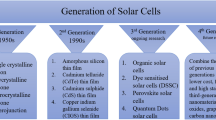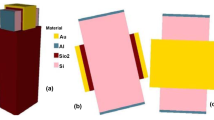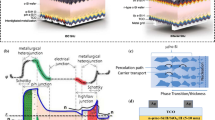Abstract
In the present work, Automat FOR Simulation of HETerostructures (AFORS-HET v2.5) simulation software was used to investigate the performance of p-type tunnel oxide passivated contact (p-TOPCon) solar cells. Firstly, the influence of SiOx thickness on the device performance at different rear surface recombination velocity (SRV) was studied thoroughly; the same was followed by the incorporation of pinholes at different oxide thickness to realize the impact of pinhole density (Dph) on the charge carrier transport mechanisms through the ultra-thin SiOx tunneling layer. Next, the doping concentration of p+ poly-Si layer was varied to reveal its impact on the device output and it was noticed that presence of pinholes might facilitate the transformation of charge carriers through ultra-thin SiOx tunneling layer even at relatively lower poly-Si doping concentration. Furthermore, the consequence of wafer thickness at different wafer lifetime and at different front SRV on the performance of p-TOPCon solar cells was studied thoroughly. A relative analysis on the device performance in between the conventional TOPCon and TOPCore (TOPCon with p-type wafer and n+ poly-Si as rear emitter) solar cell architecture based onto p-type base substrate was conducted. Eventually, an in-depth comparative analysis of the thermal stability among TOPCon, TOPCore and baseline BSF (back surface field) solar cells was carried out for both thicker and thinner wafers. The role of pinholes on the thermal stability of the devices was also pinpointed and it was yielded that our optimized device parameters might enable the best possible thermal stability along with higher power output.
Similar content being viewed by others

Data Availability
The datasets generated during the simulation study and analyses are not publicly available before publication of the manuscript as those data sets has been used to prepare the manuscript and available in the manuscript itself.
References
Liu J, Yao Y, Xiao S, Gu X (2018) Review of status developments of high-efficiency crystalline silicon solar cells. J Phys D: Appl Phys 51, article id: 123001. https://doi.org/10.1088/1361-6463/aaac6d
Farooq W, Khan AD, Khan AD, Noman M (2020) Enhancing the power conversion efficiency of organic solar cells. Optik 208:164093. https://doi.org/10.1016/j.ijleo.2019.164093
Bangash KA, Kazmi SAA, Farooq W, Ayub S, Musarat MA, Alaloul WS, Javed MF, Mosavi A (2021) Thickness optimization of thin-film tandem organic solar cell. Micromachines 12:518. https://doi.org/10.3390/mi12050518
Yang P-C, Wen H-W, Huang C-C, Yang Z-H, Liao H-L (2014) Improvement in power conversion efficiency and performance of P3HT/PCBM solar cells using dithiafulvalene-based π-conjugated oligomers. Macromol Chem Phys 215:2024 – 2034. https://doi.org/10.1002/macp.201400307
Farooq W, Alzahrani A, Ghoneim SSM (2023) Computational optimization and optical analysis of thin-film organic solar cells for high efficiency. J Comput Electron 22:867–873. https://doi.org/10.1007/s10825-023-02019-7
Reddy PJ (2012) Solar power generation: technology, new concepts & policy. CRC Press. https://doi.org/10.1201/b11886
International Technology (2022) Roadmap for Photovoltaic (ITRPV), 13th Edition
Feldmann F, Bivour M, Reichel C, Hermle M, Glunz SW (2013) A passivated rear contact for high-efficiency n-type silicon solar cells enabling high VocS and FF > 82%. 28th European PV Solar Energy Conference and Exhibition, 30 September – 4 October, Paris, France. https://doi.org/10.4229/28thEUPVSEC2013-2CO.4.4
Ghosh DK, Bose S, Das G, Acharyya S, Nandi A, Mukhopadhyay S, Sengupta A (2022) Fundamentals, present status and future perspective of TOPCon solar cells: a comprehensive review. Surf Interfaces 30. https://doi.org/10.1016/j.surfin.2022.101917
Richter A, Benick J, Feldmann F, Fell A, Hermle M, Glunz SW (2017) n-Type Si solar cells with passivating electron contact: identifying sources for efficiency limitations by wafer thickness and resistivity variation. Sol Energy Mater Sol Cells 173:96–105. https://doi.org/10.1016/j.solmat.2017.05.042
Glunz SW, Feldmann F (2018) SiO2 surface passivation layers – a key technology for silicon solar cells. Sol Energy Mater Sol Cells 185:260–269. https://doi.org/10.1016/j.solmat.2018.04.029
Richter A, Müller R, Benick J, Feldmann F, Steinhauser B, Reichel C, Fell A, Bivour M, Hermle M, Glunz SW (2021) Design rules for high-efficiency both-sides contacted silicon solar cells with balanced charge carrier transport and recombination losses. Nat Energy 6(4):429–438. https://doi.org/10.1038/s41560-021-00805-w
Mack S, Herrmann D, Lenes M, Renes M, Wolf A (2021) Progress in p-type tunnel oxide-passivated contact solar cells with screen-printed contacts. Sol RRL 2100152. https://doi.org/10.1002/solr.202100152
Gao T, Yang Q, Guo X, Huang Y, Zhang Z, Wang Z, Liao M, Shou C, Zeng Y, Yan B, Hou G, Zhang X, Zhao Y, Ye J (2019) An industrially viable TOPCon structure with both ultra-thin SiOx and n+- poly-Si processed by PECVD for p-type c-Si solar cells. Sol Energy Mater Sol Cells 200, article id: 109926. https://doi.org/10.1016/j.solmat.2019.109926
(2021) Dependence on silver could hamper Terawatt Scale Solar Module production: Report, Mercom India. https://mercomindia.com/dependence-on-silver-could-hamper/. Accessed 30 Sept 2021
Wang Q, Wu W, Yuan N, Li Y, Zhang Y, Ding J (2020) Influence of SiOx film thickness on electrical performance and efficiency of TOPCon solar cells. Solar Energy Mater Solar Cells 208. https://doi.org/10.1016/j.solmat.2020.110423
Zeng H, Tong C, Quan L, Cai Z, Yang K, Chen Z, Yuan C-H, Wu B, Yan P, Gao, Ye J (2017) Theoretical exploration towards high-efficiency tunnel oxide passivated carrier-selective contacts (TOPCon) solar cells. Sol Energy 155:654–660. https://doi.org/10.1016/j.solener.2017.07.014
Verma M, Routray S, Mishra GP (2020) Extensive study on effect of pinhole induced electric field in Si CS-TOPCon solar cell. 2020 4th IEEE Electron Devices Technology & Manufacturing Conference (EDTM), Penang, Malaysia, pp 1–4. https://doi.org/10.1109/EDTM47692.2020.9117863
Peibst R, Römer U, Larionova Y, Rienäcker M, Merkle A, Folchert N, Reiter S, Turcu M, Min B, Krügener J, Tetzlaff D, Bugiel E, Wietler T, Brendel R (2016) Working principle of carrier selective poly-Si/c-Si junctions: is tunnelling the whole story? Sol Energy Mater Sol Cells 158:60–67. https://doi.org/10.1016/j.solmat.2016.05.045
Lancaster K, Großer S, Feldmann F, Naumann V, Hagendorf C (2016) Study of pinhole conductivity at passivated carrier-selected contacts of silicon solar cells. 6th International Conference on Silicon Photovoltaics, Silicon PV Energy Procedia, vol 92, pp 116–121, 2016. https://doi.org/10.1016/j.egypro.2016.07.040
Choi S, Min KH, Jeong MS, Lee JI, Kang MG, Song H-E, Kang Y, Lee H-S, Kim D, Kim K-H (2017) Structural evolution of tunneling oxide passivating contact upon thermal annealing. Sci Rep 7(12853). https://doi.org/10.1038/s41598-017-13180-y
Tetzlaff D, Krügener J, Larionova Y, Reiter S, Turcu M, Haase F, Brendel R, Peibst R, Höhne U, Kähler J-D, Wietler TF (2017) A simple method for pinhole detection in carrier selective POLO-junctions for high efficiency silicon solar cells. Sol Energy Mater Sol Cells 173:106–110. https://doi.org/10.1016/j.solmat.2017.05.041
Wietler TF, Tetzlaff D, Krügener J, Rienäcker M, Haase F, Larionova Y, Brendel R, Peibst R (2017) Pinhole density and contact resistivity of carrier selective junctions with polycrystalline silicon on oxide. Appl Phys Lett 110:461–466. https://doi.org/10.1063/1.4986924
Peibst R, Römer U, Hofmann KR, Lim B, Wietler TF, Krügener J, Harder N-P, Brendel R (2014) A simple model describing the symmetric I-V characteristics of p polycrystalline Si/n monocrystalline Si, and n polycrystalline Si/p monocrystalline Si junctions. IEEE J Photovolt 4(3):841–850. https://doi.org/10.1109/JPHOTOV.2014.2310740
Feldmann F, Nogay G, Polzin J, Steinhauser B, Richter A, Fell A (2018) A study on the charge carrier transport of passivating contacts. IEEE J Photovolt 8(6):1503–1509. https://doi.org/10.1109/JPHOTOV.2018.2870735
Brendel R, Peibst R (Nov. 2016) Contact selectivity and efficiency in crystalline silicon photovoltaics. IEEE J Photovolt 6(6):1413–1420. https://doi.org/10.1109/JPHOTOV.2016.2598267
Rienäcker M, Bossmeyer M, Merkle A, Römer U, Haase F, Krügener J, Brendel R, Peibst R (2017) Junction resistivity of carrier-selective polysilicon on oxide junctions and its impact on solar cell performance. IEEE J Photovolt 7(1):11–18. https://doi.org/10.1109/JPHOTOV.2016.2614123
Folchert N, Rienäcker M, Yeo AA, Min B, Peibst R, Brendel R (2018) Temperature-dependent contact resistance of carrier selective Poly-Si on oxide junctions. Sol Energy Mater Sol Cells 185:425–430. https://doi.org/10.1016/j.solmat.2018.05.046
Čampa A, Smole F, Folchert N, Wietler T, Min B, Brendel R, Topič M (2019) Detailed analysis and understanding of the transport mechanism of poly-si-based carrier selective junctions. IEEE J Photovolt 9(6):1575–1582. https://doi.org/10.1109/JPHOTOV.2019.2943610
Galleni L, Fırat M, Radhakrishnan HS, Duerinckx F, Tous L, Poortmans J (2021) Mechanisms of charge carrier transport in polycrystalline silicon passivating contacts. Sol Energy Mater Sol Cells 232. https://doi.org/10.1016/j.solmat.2021.111359
Yang Z, Liu Z, Cui M, Sheng J, Chen L, Lu L, Guo W, Yang X, Zhao Y, Yang W, Greer JC, Zeng Y, Yan B, Ye J (2021) Charge-carrier dynamics for silicon oxide tunneling junctions mediated by local pinholes. Cell Rep Phys Sci 2(12). https://doi.org/10.1016/j.xcrp.2021.100667
Zhang Z, Zeng Y, Jiang C-S, Huang Y, Liao M, Tong H, Al-Jassim M, Gao P, Shou C, Zhou X, Yan B, Ye J (2018) Carrier transport through the ultrathin silicon-oxide layer in tunnel oxide passivated contact (TOPCon) c-Si solar cells. Sol Energy Mater Sol Cells 187:113–122. https://doi.org/10.1016/j.solmat.2018.07.025
Feldmann F, Nogay G, Löper P, Young DL, Lee BG, Stradins P, Hermle M, Glunz SW (2018) Charge carrier transport mechanisms of passivating contacts studied by temperature-dependent J-V measurements. Sol Energy Mater Sol Cells 178:15–19. https://doi.org/10.1016/j.solmat.2018.01.008
Varache R, Leendertz C, Gueunier-Farret ME, Haschke J, Muñoz D, Korte L (2015) Investigation of selective Junctions using a newly developed tunnel current model for solar cell applications. Sol Energy Mater Sol Cells 141:14–23. https://doi.org/10.1016/j.solmat.2015.05.014
Chuchvaga NA, Zhilina DV, Zhantuarov SR, Zh S, Tokmoldin EI, Terukov, Tokmoldin NS (2018) Study and optimization of heterojunction silicon solar cells. J Phys : Conf Ser 993. https://doi.org/10.1088/1742-6596/993/1/012039
Liu Z, Yang Z, Wang W, Yang Q, Han Q, Ma D, Cheng H, Lin Y, Zheng J, Liu W, Liao M, Chen H, Wang Y, Zeng Y, Yan B, Ye J. Numerical and experimental exploration towards a 26% efficiency rear-junction n-type silicon solar cell with front local-area and rear full-area polysilicon passivated contacts. Sol Energy 221:1–9. https://doi.org/10.1016/j.solener.2021.04.020
Schenk A, Heiser G (1997) Modeling and simulation of tunneling through ultra-thin gate dielectrics. J Appl Phys 81(12):7900–7908. https://doi.org/10.1063/1.365364
Anand N, Kale P (2021) Optimization of TOPCon structured solar cell using AFORSHET. Trans Electr Electron Mater 22:160–166. https://doi.org/10.1007/s42341-020-00220-0
Dikshit AK, Mandal NC, Bose S, Mukherjee N, Chakrabarti P (2019) Optimization of back ITO layer as the sandwiched reflector for exploiting longer wavelength lights in thin and flexible (30 µm) single junction c-Si solar cells. Sol Energy 193:293–302. https://doi.org/10.1016/j.solener.2019.09.017
Richter A, Benick J, Müller R, Feldmann F, Reichel C, Hermle M, Glunz SW (2017) Tunnel oxide passivating electron contacts as full-area rear emitter of high-efficiency p-type silicon solar cells. Prog Photovolt Res Appl 26(8):579–586. https://doi.org/10.1002/pip.2960
Feldmann F, Simon M, Bivour M, Reichel C, Hermle M, Glunz SW (2014) Efficient carrier-selective p- and n-contacts for Si solar cells. Sol Energy Mater Sol Cells 131:100–104. https://doi.org/10.1016/j.solmat.2014.05.039
Acharyya S, Sadhukhan S, Panda T, Ghosh DK, Mandal NC, Nandi A, Bose S, Das G, Banerjee D, Maity S, Chaudhuri P, Saha H (2022) Performance analysis of different dielectrics for solar cells with TOPCon structure. J Comput Electron 21:471–490. https://doi.org/10.1007/s10825-022-01866-0
Acknowledgements
The present work has been carried out in DST-IIEST Solar PV Hub and supported by Department of Science and Technology (DST/TMD/SERI/HUB/2(G), Govt. of India (GOI). One of the authors, Dibyendu Kumar Ghosh is thankful to Ministry of New and Renewable Energy (MNRE), India for providing him the research fellowship.
Funding
The work was supported by Department of Science and Technology, DST/TMD/SERI/HUB/2(G), Govt. of India (GoI). One of the authors Dibyendu Kumar Ghosh is acknowledging Ministry of New and Renewable Energy (MNRE), India for their financial support for carrying out his doctoral studies.
Author information
Authors and Affiliations
Contributions
Dibyendu Kumar Ghosh (Simulation and Analysis, Preparing Manuscript), Shiladitya Acharyya (Analysis), Sukanta Bose (Preparing Manuscript), Gourab Das (Conceptualizing and Proof), Sumita Mukhopadhyay (Supervising), Anindita Sengupta (Mentor). All authors read and approved the final manuscript.
Corresponding author
Ethics declarations
Ethics Approval
NA.
Consent to Participate
NA.
Consent for Publication
NA.
Competing Interests
The authors declare no competing interests.
Additional information
Publisher’s Note
Springer Nature remains neutral with regard to jurisdictional claims in published maps and institutional affiliations.
Rights and permissions
Springer Nature or its licensor (e.g. a society or other partner) holds exclusive rights to this article under a publishing agreement with the author(s) or other rightsholder(s); author self-archiving of the accepted manuscript version of this article is solely governed by the terms of such publishing agreement and applicable law.
About this article
Cite this article
Ghosh, D.K., Acharyya, S., Bose, S. et al. A Detailed Theoretical Analysis of TOPCon/TOPCore Solar Cells Based on p-type Wafers and Prognosticating the Device Performance on Thinner Wafers and Different Working Temperatures. Silicon 15, 7593–7607 (2023). https://doi.org/10.1007/s12633-023-02606-0
Received:
Accepted:
Published:
Issue Date:
DOI: https://doi.org/10.1007/s12633-023-02606-0



